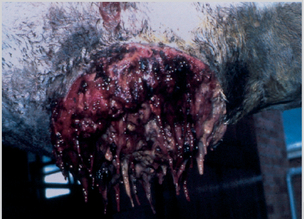4 Factors that disturb normal corrective processes inevitably complicate wound healing. Early recognition of healing difficulties allows prompt correction. Delayed healing inevitably results in development of chronic inflammation, and although transition through the chronic inflammatory stage is almost inevitable in naturally occurring wounds, it is the most undesirable event in the healing cascade. Infected wounds heal slower than uninfected ones. Mixed infections are relatively common (Figure 27), and tissue bacteria numbers above 1 × 106 organisms delays healing6. Bacterial species that produce collagenase or other destructive enzymes have a profound effect on healing (Figure 28). Figure 27 An infected granulating wound on the distal cannon. A mixed growth of bacteria was cultured. Figure 28 A severely infected non-healing wound from which a pure growth of Pseudomonas aeruginosa was cultured. Infection with Staphylococcus aureus can cause pyogranuloma within the wound site. Clinically this resembles both granulation tissue and sarcoid, but histologically diffuse microabscessation is present (Figure 29). Figure 29 This wound failed to heal because of staphylococcal microabscessation (pseudomycetoma/botriomycosis). Fungal infections of superficial wounds is relatively common. For example, Pythius spp., or Basidiobolus haptosporus infection (deep or superficial mycosis or hyphomycosis) can be catastrophic complications of relatively trivial wounds. Parasitic infestation, e.g. with Habronema musca or the larvae of certain flies (myiasis), also retards healing (Figure 30). The larvae of Lucilla sericata has been found to have a beneficial debriding effect in some wounds under controlled conditions. Movement at the site or in the attached tissues delays healing (Figure 31). Excessive mobility disrupts capillary buds and increases collagen deposition, directing the healing process towards chronic inflammatory status. Anatomical knowledge may establish the likelihood of deep tissues that are moving significantly relative to the wound itself. Wounds on the body may fail to heal because of movement of the underlying muscle, but this is less significant in horses. Figure 31 This wound failed to heal because of movement of the damaged common extensor tendon. Movement of joints also causes delays in healing.
Factors that Delay Healing
Infection/Infestation
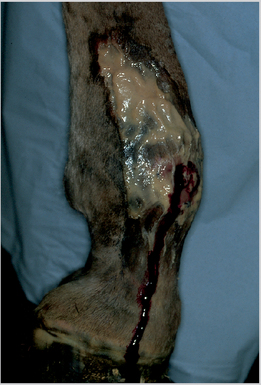
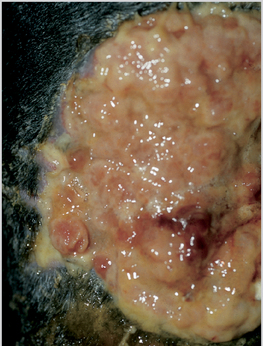
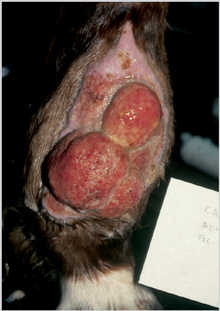
Movement
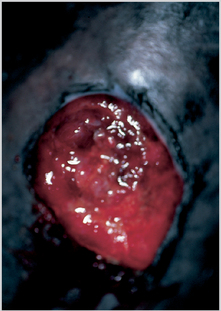
![]()
Stay updated, free articles. Join our Telegram channel

Full access? Get Clinical Tree


 . Infection/Infestation
. Infection/Infestation . Movement
. Movement . Foreign Body
. Foreign Body . Necrotic Tissue
. Necrotic Tissue . Altered Local pH
. Altered Local pH . Paucity of Blood Supply
. Paucity of Blood Supply . Poor (or Impaired) Oxygen Supply
. Poor (or Impaired) Oxygen Supply . Poor Nutritional and Health Status
. Poor Nutritional and Health Status . Local Factors
. Local Factors . Iatrogenic Factors
. Iatrogenic Factors . Genetic Factors
. Genetic Factors . Cell Transformation
. Cell Transformation